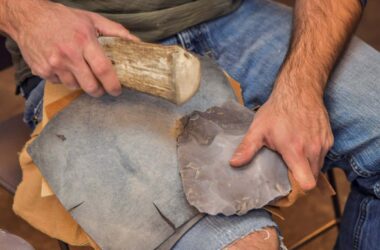Pollen data present the panorama was dominated by pasture animals, suggesting the presence of nomadic herders
DIMITRIOS TILIS/Getty Omages
An evaluation of pollen from Lake Volvi in Greece has unexpectedly revealed that nomads thrived on this area for hundreds of years after the chaos unleashed by the collapse of the Roman Empire.
Adam Izdebski on the Max Planck Institute of Geoanthropology in Germany and his colleagues have been finding out sediment cores from the lake as half of a bigger examine. As lake sediments construct up, adjustments within the abundance of assorted sorts of pollen within the sediment layers can report how close by vegetation modified over time.
In another locations across the Mediterranean, the workforce has discovered indicators of reforestation after the collapse of the Western Roman Empire round AD 476. However at Lake Volvi, from round AD 540, the workforce discovered much less tree pollen however extra pollen from crops related to nomadic livestock herders. These nomads have been returning to the identical areas seasonally, so planted some crops, equivalent to barley.
“We’ve got this second when the Roman agriculture disappears nearly fully as a consequence of plague, local weather change and warfare, however you don’t get reforestation – you really get much less forest in a short time,” says Izdebski.
“The panorama was dominated by pasture animals even within the excessive mountain areas. This was an entire shift from how the Romans farmed the lowlands for a number of hundred years.”
This implies these earlier farmers moved away, died or adopted a nomadic way of life, he says.
Greece was nominally below the management of the Japanese Roman, or Byzantine, Empire round on the time of this shift. It’s identified that the area was raided by Bulgar nomads round AD 540, nevertheless it wasn’t identified that nomads lived on this area for a number of centuries.
The one historic data that correlates with the workforce’s findings is an account of a Byzantine emperor being ambushed by Bulgar nomads round AD 700.
“Plainly there was an area society that didn’t need any emperor to be round,” says Izdebski, who offered the findings on the assembly of the European Geosciences Union in Vienna, Austria, final month.
Round AD 850, the Byzantine Empire reasserted management and the indicators of nomads disappear. As a substitute, there was reforestation.
The findings present uncommon proof of the presence of nomadic peoples at a specific place and time, says Izdebski. “We all know little or no about their historical past as a result of the states weren’t enthusiastic about recording them.”
Historians didn’t write about nomadic peoples as they weren’t a part of the elites, he says. And since nomads have been tough to tax, there aren’t any tax data both – tax data could be a wealthy supply of details about previous populations.
Matters:












